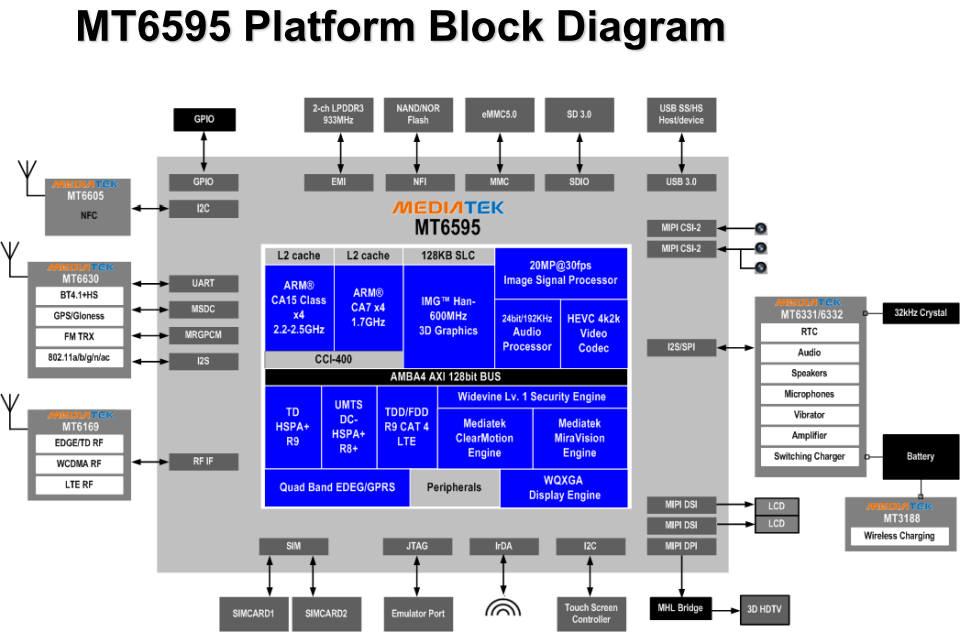MediaTek MT6595: 8 Cores, Cortex-A17, PowerVR Rogue, LTE
Chinese chipset maker MediaTek has announced a new SoC for smartphones and tablets that promises to take the company into new markets. The octo-core MT6595 features big.LITTLE ARM Cortex-A17, PowerVR Rogue Series 6, H.265 UHD video, 802.11ac, and LTE.

Cortex-A17, big.LITTLE, And CorePilot
The MT6595 is MediaTek’s second generation Octo-core SoC. Previously, the company’s MT6592 used eight Cortex-A7 CPU cores running at 1.7 GHz. These cores would all operate in tandem, with up to four of them being able to run at 2 GHz simultaneously to meet demand. For those applications able to take advantage of eight threads, such as Chrome and Antutu, the chip posted notable CPU performance. The issue was that so few applications were so heavily-threaded and so the MT6592 didn’t offer very remarkable CPU performance in most everyday tasks.

MT6595 seeks to address this with a different approach: big.LITTLE. In this case. MT6595 offers four ARM Cortex-A17 cores running at 2.2 GHz and another four ARM Cortex-A7 at 1.7 at GHz. In this big.LITTLE implementation, all eight cores can actually work in tandem via MediaTek’s own CorePilot Heterogeneous Multi-Processing (HMP) platform. In practice, that means when processing demand is low, only the four Cortex-A7 cores will be in use, improving battery efficiency. However, when demand is high, like when playing a game or using a complex app, all cores can go active at the same time, including the much more powerful Cortex-A17 quad, which reportedly offers up a 60% performance improvement over Cortex-A15. CorePilot can dynamically switch cores in and out individually, based on demand. In some ways, this makes MT6595 more advanced than even Samsung’s big.LITTLE octo-core SoC, the Exynos 5 - at least on paper, for now. Unfortunately, benchmarks aren’t yet available, and devices using MT6595 won’t ship until early Q2 2014, but we will be testing these claims, be assured.
PowerVR Rogue Series 6 "Han" And Ultra HD Video
For gaming, MT6595 implements PowerVR’s Rogue series 6 GPU. Codenamed “Han”, this GPU core is clocked at 600 MHz. While documentation is scant, it seems this is based around the low power G6200 two-cluster core, unlike Apple’s A7, which uses the much faster G6430 four-cluster core. Preliminary benchmarks of MediaTek’s own MT8135 budget dual-core SoC, which also carries this GPU (at least in name) seem to place it near or better than Qualcomm’s Adreno 320. While that’s not topping benchmarks, it’s certainly fast enough for most of today’s mobile games, and it may well be that MT6595’s implementation is faster than the MT8135 benchmarks seem to indicate.

On the multimedia side, MediaTek offer its own media processing subsystems which the company developed in-house. For video, MT6595 includes the first H.265 Ultra HD hardware-accelerated codec with additional support for H.264 and VP9, all in UHD. Additionally, it implements two post-processing technologies: ClearMotion to eliminate frame jitter, and Miravision to aid in picture clarity when streaming. For audio, MT6595 supports 24-bit 192 kHz Hi-Fi-quality audio with an on-chip high-performance DAC that offers supposedly >110 dB signal-to-noise ratio. Finally, MT6595 implements 20MP camera capability and supports up to 2560x1600 WQXGA for display output. Clearly, MediaTek is aiming this SoC squarely at the media consumption market.
LTE, Wi-Fi, Bluetooth, And Wireless Charging
MT6595 is the first MediaTek SoC to take on many modern Wireless technologies. It supports 802.11ac and 4G LTE, putting it in the same tier as many more expensive SoCs. It aims to fix the positioning issues which have plagued earlier chipsets by implementing Multi-GNSS positioning systems, including GPS, GLONASS, Beidou, Galileo, and QZSS. This should help positioning no matter where you might be on the globe. MT6595 also adds support for a low-power Bluetooth LE stack and ANT+ fitness tracking devices (like pedometers). Finally, MT6595 implements MediaTek’s own competitor to Qi Wireless charging called “Multimode”, and it supports Qi devices along with other standards.
Promising Premium Performance At Budget Pricing
With MT6595, MediaTek will be the first to market with ARM Cortex-A17, but it remains to be seen whether its big.LITTLE HMP implementation and potentially-hobbled PowerVR Rogue 6 “Han” GPU will allow the company to break through the mid-range performance barrier while still maintaining a budget price.
Follow Dorian and Tom’s Hardware on Google+
Get Tom's Hardware's best news and in-depth reviews, straight to your inbox.
-
greghome just Announced ? I thought these were already powering Lenovo's S939 smartphone since DecemberReply -
ZolaIII Nice all around!I wonder why they didn't go with new Rogue 7 gen & same two cluster (basic model) as it's much more power efficient?Reply -
aldaia "Promising Premium Performance At Budget Pricing"Wasn't that Intel's hope to enter the smartphone market?Reply -
ZolaIII @aldaiaWell there where speculation that they (Intel) even what to bay MediaTek. A little to late now!I never heard about A17? Last core that I know ARM did introduced is a A12 & first market designs are expected in 1Q this year.As it's performance wise presented hire it looks like a stripped down (only 32 bit) Cortex A57...Reply -
mikeangs2004 The lower end GPU defeats the purpose of this system.Also, is the audio hardware accelerated with DSP's?Reply -
icrf I thought this wasn't out until H2, not Q2. Considering ARM just announced the A17 and they're saying 2015, I didn't think MediaTek was jumping the gun by that much.Reply -
ZolaIII Cortex A17 is a up to 60% (around 4 dmips) faster from A9 & this put him to be around 14% faster then A15.Reply
Then again this specification puts CPU clock speeds much higher than ARM did bat I don't doubt that they can do it as they did with A7. -
amk-aka-Phantom I HATE MEDIATEK. No devices with their chips support Cyanogenmod, making them useless. This company needs to die!Reply -
ninong have they fixed their gps problems yet? i've had 2 mediatek phones (a dual core & mt6589) and none of them have a working gpsReply